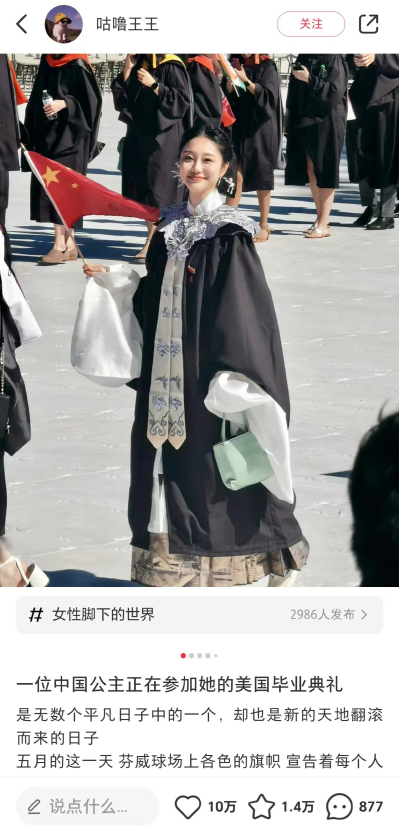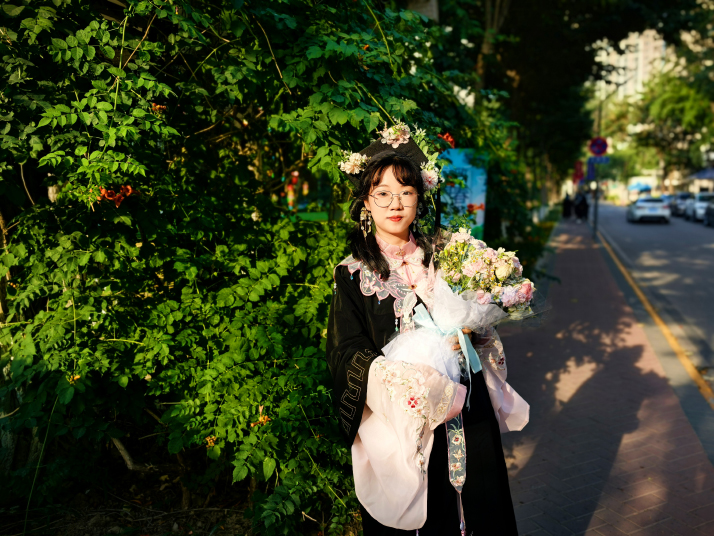| China |
| From Ming Dynasty to modern commencement: graduates tszuj up their graduation gowns | |
|
|
 A Xiaohongshu post showcasing an outfit that mixes and matches the yunjian and mamian (SCREENSHOT)
College graduation marks the conclusion of one's student years and the beginning of a new life chapter. Graduates worldwide celebrate this milestone in different ways, often through ceremonies with students wearing caps and gowns to accept their hard-earned degrees, as well as parties and parades amid a colorful backdrop of balloons, confetti and flowers. In China, a host of graduating college students in late June embraced a new trend in graduation attire. These fresh graduates adorned their gowns with Chinese cultural elements, including the yunjian (a cloud-shaped cape), zanhua (flower decorations specifically used on caps), and the mamian, a style of pleated dress originating from the Ming Dynasty (1368-1644). Both the yunjian and mamian fall under the hanfu category, with hanfu being the traditional dress of the Han Chinese. "I've photographed over 100 graduates since mid-June, and my customers are crazy about these trending outfits," Li Shuo, a freelance photographer based in Beijing's Haidian District, where many of the capital city's universities are located, told Beijing Review. He mentioned that he now offers a rental service for the "three-piece guochao graduation package" due to the high demand for this photoshoot style. Guochao, or China chic, refers to the young Chinese preference for products infused with traditional cultural elements. Originating in the fashion business in the late 2010s, guochao has since expanded into many sectors, from furniture to everyday items. "My customers have expressed that these decorations not only add a touch of traditional Chinese essence to their graduation celebrations but also brighten up the solemn black gowns—matching their joyous mood," Li added. "I believe it is a wonderful way to keep our culture alive by seamlessly integrating it into contemporary life." Back to the beginning Though students may associate 2024 with the rise of the "three-piece guochao graduation package," it actually took a year for this set to materialize. The wider trend of wearing the yunjian and mamian gained popularity much earlier. In May 2023, a graduate surnamed Wang from Northeastern University in the United States showcased her graduation attire, a mix and match of the yunjian and mamian, on Xiaohongshu, a popular lifestyle and e-commerce app in China. Her posts soon began trending, garnering over 100,000 likes each and inspiring tens of thousands of Chinese students around the world to emulate her style, wearing mamian dresses underneath yunjian capes. The graduation gowns of China's higher education institutions were not standardized until the 1990s, influenced by Western gown designs and initially devoid of Chinese cultural elements. "I think it's great that Chinese students are embracing and proudly displaying our culture by wearing traditional attire for their graduation ceremonies," Emma Liu, a Chinese graduate from New York University, told Beijing Review. "During livestreamed graduation ceremonies, which attract thousands of viewers, I've often seen students from other countries adding their own traditional elements, waving national flags or drawing cultural symbols on their bodies. Since last year, we've started to see a Chinese version of this celebratory expression." Tracing its origins back to the Qin Dynasty (221-207 B.C.), the yunjian originally served to keep the collar and shoulders clean. Over time, the capes evolved into decorative items, often bearing colorful embroidery featuring auspicious motifs such as fish, birds, clouds, sea waves, flowers and symbolic characters. In recent years, the yunjian has experienced a resurgence alongside the hanfu revival. Some Chinese universities have even incorporated the cape into their official graduation attire. For instance, in June, Shandong University in Shandong Province introduced its latest graduation gowns, accompanied by specially designed yunjian capes given as gifts to graduates. The capes were modified with edges shaped like peaches and fishtails, symbolizing auspiciousness and conveying wishes of success to the university's graduates, who are seen as future contributors to the nation's progress.  A student poses for her graduation photo adorned with a zanhua cap and a yunjian cape, complemented by hanfu underneath, in Beijing on June 19 (COURTESY PHOTO)
DIY cap couture This year, apart from experimenting with new modish arrangements, students are embellishing their caps using the traditional Chinese craft of zanhua, literally meaning "pinning flowers," to express their hopes for the future. This type of decoration lifts the combination of their gowns and mamian dresses to new levels of fashion. This graduation season, Xiaohongshu has seen over 10,000 posts from graduates sharing their experiences of creating and wearing their personalized zanhua caps. Popping up in records dating back to the Tang Dynasty (618-907), the art of "pinning flowers" is cherished for its aesthetic beauty and auspicious symbolism. It allegedly emerged from the port city of Quanzhou in today's southeastern province of Fujian, one of the starting points of the ancient Maritime Silk Road, where the zanhuawei ("floral headdress") was a traditional symbol of the women in the city's Xunpu Village. During the Song Dynasty (960-1279), emperors bestowed zanhua upon officials as a gesture of appreciation, with different flowers and colors symbolizing different official ranks and social statuses. The craft was further used in ceremonies such as imperial examinations, final court selections for officials, as well as celebratory and sacrificial events. In 2008, Quanzhou's zanhua craft was recognized as national intangible cultural heritage. "I opted for bright orange and yellow flowers to decorate my bachelor's cap because they go well with my pink collar and symbolize a bright future," Chen Yan, a fresh college graduate in Changsha, Hunan Province, told Beijing Review. "And I used traditional calligraphy to add a poem by my favorite poet, Li Bai (701-762), on the side—conveying my hopes for my future career." In China, bachelor's gowns come with six different collar colors, each representing an academic discipline: pink signifies humanities, gray denotes science, yellow represents engineering, green represents agriculture, white is for medicine, and red signifies military studies. When purchasing DIY zanhua packages, students often consider the color of their collars to maximize the visual impact. "I bought a DIY zanhua pack on Xiaohongshu, and there are thousands of posts teaching you how to do it," Chen explained. "I decorated my cap within 30 minutes. I think it's cheaper and more meaningful to personalize your own cap, and it feels good to keep our traditional culture alive [by doing so]." Chen is not the only graduate delving into the world of DIY zanhua caps. Currently, Xiaohongshu offers over 1,600 types of these "cap couture" packs, varying in colors, materials, sizes and prices. According to data from Taobao, the online retail platform of e-commerce giant Alibaba, the sales of zanhua caps and zanhua DIY packs surged by 336 percent during this graduation season. Chen further explained that the materials and techniques needed to create a zanhua cap are adapted and simplified from traditional practices, which typically require years of training to master. "My mother is from Quanzhou and her hometown is renowned for the traditional zanhua technique," she explained. "I never learned how to 'pin flowers,' but I think that by using the DIY package, I'm contributing to the vitality of this old culture. And I'm glad so many people are keeping our traditional culture alive together." (Print Edition Title: Caps and Clouds) Copyedited by Elsbeth van Paridon Comments to zhangyage@cicgamericas.com |
|
||||||||||||||||||||||||||||||
|